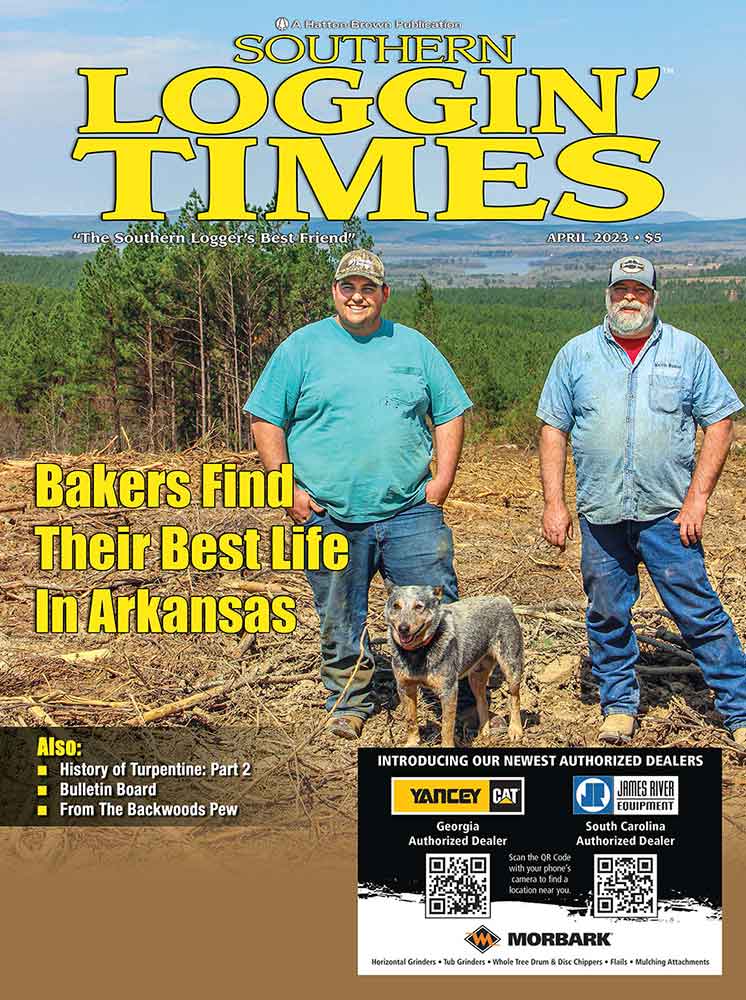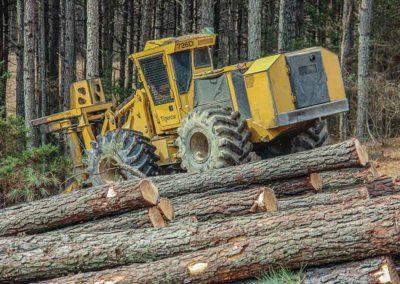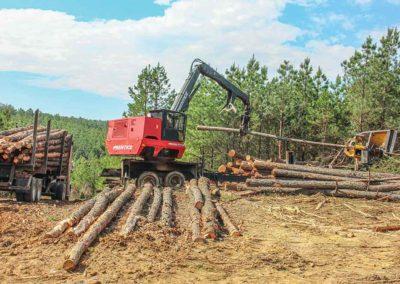April 2023
MALVERN, Arkansas – Cody Baker, 27, calls his company Baker Land and Cattle, but these days his business is in the woods, not the pastures. The name may be misleading, but it’s also appropriate. Baker and his dad, Kevin, 52, don’t actually run cattle anymore, but they did for a long time, and in fact that’s what led them to logging.
Inside This Issue
COVER: Bakers Find Their Best Life In Arkansas
MALVERN, Arkansas – Cody Baker, 27, calls his company Baker Land and Cattle, but these days his business is in the woods, not the pastures. The name may be misleading, but it’s also appropriate. Baker and his dad, Kevin, 52, don’t actually run cattle anymore, but they did for a long time, and in fact that’s what led them to logging.
Article by David Abbott, Managing Editor, Southern Loggin’ Times
SOUTHERN STUMPIN': Lonoke, Arkansas, 1952
Couple weeks ago I went on the road to visit some loggers in Mississippi and Arkansas (one, the fabulous Baker boys of Malvern, appears in this issue). My first night on the road took me up from Mississippi through Memphis and west from there on I-40. I stopped around 10 p.m. at the first hotel I saw, a Holiday Inn Express off a random exit somewhere east of Little Rock. It didn’t really matter where it was; it was just a place to sleep a few hours before continuing on my journey the next morning. All the same, just out of curiosity, when I registered at the front desk, I asked the hotel clerk, “What town is this?” “Lonoke,” she answered. “Well, I’ll be,” I nodded. “Lonoke, Arkansas. That’s where my dad was born, 81 years ago.”
Article by David Abbott, Managing Editor, Southern Loggin’ Times
Rise And Fall: The History Of Turpentine Part Two
Second Of Three Parts
A major breakthrough in the naval stores sector occurred around 1902 when University of Georgia chemist Charles Herty designed and patented the cup-and-gutter gum collection system, a big improvement over the traditional box (cavity) method. Herty’s invention was less intrusive and thus helped prolong tree life while making gum collection easier, faster, cleaner and less wasteful.
Article by DK Knight, Publisher/Editor Emeritus, Southern Loggin’ Times
BULLETIN BOARD
Our Best Leisure Selections From Our Not-So-Sharp Minds
FROM THE BACKWOODS PEW: Food Piles
Are we building our “food piles,” the supplies to see us through the upcoming winter, with items of junk? Perhaps we are collecting things that may look pretty, that may take great time and energy to acquire? But at the end, when that icy hand of death takes hold of us, what will we have? Just as a solid food pile will allow a beaver to survive the winter, laying up treasure in heaven will allow us to live in heaven.
Bradley Antill is a forester and an author. Excerpted from Bibles, Beavers, and Big Timber.
INDUSTRY NEWS ROUNDUP
- Spectrum Moves Ahead At Adel
- Homan Industries Names Reaves CEO
- Hunt FP Supports Forest Products Center
- Campbell Global Adds SE Timberland
- Georgia-Pacific Contributes To CLT Project
- Canfor DeRidder Has Log Cranes In Place
- Purdue Grant Focuses On Forest Development
AS WE SEE IT: The Roaring Twenties – 1923 vs. 2023
The American Loggers Council (ALC), because of who we are (you) and what we represent, is widely recognized and respected. That is why the American Loggers Council was invited to attend the Coolidge Foundation centennial celebration of the Presidency of Calvin Coolidge. Coincidentally, when Calvin Coolidge was Vice President he lived at the Willard Hotel, the same place that the American Loggers Council will be hosting the 2023 DC Fly-In and where the Council office is.
Article by Scott Dane, Executive Director of the American Loggers Council
MACHINES-SUPPLIES-TECHNOLOGY
- Falcon Slash Rake
- Link-Belt 40B Forestry Series
TRUCKING SAFETY
Accidentally In Logs
Article by David Abbott, Managing Editor, Southern Loggin’ Times
MALVERN, Arkansas – Cody Baker, 27, calls his company Baker Land and Cattle, but these days his business is in the woods, not the pastures. The name may be misleading, but it’s also appropriate. Baker and his dad, Kevin, 52, don’t actually run cattle anymore, but they did for a long time, and in fact that’s what led them to logging.
Cody went to work for himself shortly after graduating high school in 2014, but he did not initially set out intending to go into the logging business. “I got into logging by accident,” he jokes. Kevin had done some small scale logging years before, but had spent his life mostly in construction and cattle farming. With a similar career path in mind, Cody bought 140 acres right after high school, aiming to use it for pasture. He bought some old and worn out logging equipment to clear it for that purpose, hoping to offset some of the cost by logging it himself. After finishing, he realized he really enjoyed the logging, and decided to try more of it. Nine years have passed and he’s still in timber.
They got out of the cattle business then, but Kevin plans to eventually return to his roots there, once Cody no longer needs his help in the woods. He wants to do it so his grandkids can grow up around it the way Cody did. “It taught him a lot of responsibility and I want my grandkids to learn the same responsibility,” the elder Baker says. For now, though, logging takes up all their time.
Logging wasn’t plan A for Cody; he also didn’t really set out to have an outfit quite so big. On a single crew, the Bakers run two loaders, two skidders and a cuter, with multiple backups.
“We were sort of forced into getting as big as we are,” the younger Baker explains. “When we first started we had trouble with quotas. We were small so we were the first ones they wouldn’t let haul.” Now they haul a minimum 15 daily loads, often getting closer to 20. “We have to have 75-80 loads a week just to survive right now, the way we are set up, Kevin says. “Rain won’t let you get more than that in the winter and in the summer mill quotas won’t let you get more, so you can only increase production so much.” Trucks make four or five trips each per day, which is possible because mills are within 50 miles. “With fuel as high as it is there is no money in hauling long distances,” Kevin continues.
They have six trucks (mostly Macks with Kenworth and Western Star in the mix) and 10 trailers (Pitts, Magnolia, Viking), but don’t run them all full-time. “Finding drivers is the biggest problem we face,” Cody says. “I think it’s everybody’s problem.”
Have A Question?
Send Us A Message



